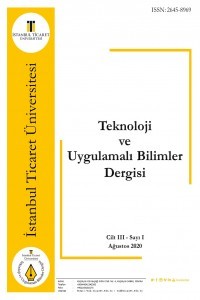Sıradaki Hücre Tahmini için Döngü Tabanlı Markov Zinciri
5. Jenerasyondaki (5G) gelişmeyle beraber Yazılım Tanımlı Ağ (SDN) ve Ağ Fonksiyonunu Sanallaştırma (NFV) gibi 5G’nin temel taşları da geliştirilmeye başlandı. 5G’nin en büyük geliştirmelerinden biri de, Makineden Makineye (M2M) haberleşme yoğunluğunun, önceki jenerasyonlara kıyasla oldukça artacak olmasıdır. Dolayısıyla bu makinelerin (ya da kullanıcı ekipmanlarının) takibi de kritik hale gelecektir. Bu takibin ve bunun gibi kritik görevlerin, 5G’de NFV yeniliğiyle yapılabilmesi adına çeşitli Ağ Fonksiyonlarına (NF) belirli görevler verilmiştir. Bu fonksiyonlardan Ağ Veri Analitiği Fonksiyonu (NWDAF), diğer Ağ Fonksiyonlarından verileri toplayarak analitik (yani istatistik ya da tahmin) oluşturmakla görevlendirilmiştir. Özellikle tahminleri oluşturmak için, NWDAF içerisinde belirtilen operasyonlar için Makine Öğrenmesi (ML) Modelleri ve Yapay Zeka (AI) kullanmak mümkün olacaktır. Bu çalışmada ise, yeni bir döngü tabanlı yaklaşımla Markov Zinciri kullanılarak bir Kullanıcı Ekipmanı için bir sonraki olası hücre tahmin edilmektedir.
Anahtar Kelimeler:
5G Ağ Fonksiyonları, Ağ Veri Analitiği Fonksiyonu, Kullanıcı Ekipmanı Hareketliliği, Markov Zinciri
Loop-based Markov Chain for Next Cell Prediction
With the development in the 5G, Software Defined Networking(SDN), Network Function Virtualization(NFV), which are the cornerstones of the 5G, are being developed as well. One of the biggest development of 5G is, dense of Machine-to-Machine (M2M) communication is excessively increased compared to older generations. Therefore, monitoring of these machines (or user equipment) will also become critical. Various Network Functions (NFs) have been given specific tasks so that this monitoring and other critical tasks can be done with the NFV innovation in 5G. Network Data Analytics Function (NWDAF), one of these functions, is responsible for creating analytics (i.e., statistics or predictions) by collecting data from other Network Functions. In particular, in order to generate predictions, it will be possible to use Machine Learning (ML) Models and Artificial Intelligence (AI) for the operations specified within the NWDAF. In this study, next possible cell for a User Equipment is predicted by using Markov Chain with novel loop-based approach.
Keywords:
5G Network Functions, Markov Chain, Network Data Analytics Function, User Equipment Mobility,
___
- 3GPP. (2018). TS 29.518. 3rd Generation Partnership Project.
- 3rd Generation Partnership Project [3GPP]. (2019). TS 23.288. 3rd Generation Partnership Project.
- Ben L., Chansu Y., Myungchul W., Seung-Min P., Weetit W., & Won-Tae K. (2011). Behavior-based mobility prediction for seamless handoffs in mobile wireless networks. Wireless Networks, 17(3), 645-658.
- Bui N., Cesana M., Hosseini S. A., Liao Q., Malanchini I., & Widmer J. (2016, June 1). Anticipatory Networking in Future Generation Mobile Networks: a Survey , arXiv.
- Changchun P., Ganke Y., Haichun L., & Junjie J. (2016). Predicting Human Mobility Based on Location Data Modeled by Markov Chains. 2016 Fourth International Conference on Ubiquitous Positioning, Indoor Navigation and Location Based Services (UPINLBS) (s. 145-151). Shanghai: IEEE.
- Duong T. & Tran D. Q. (2015, December). A Fusion of Data Mining Techniques for Predicting Movement of Mobile Users. Journal of Communications and Networks, 17(6), 568-581.
- Fehmi B. A., Jie Y., Xinyu Z., Yanting Z., Yuanyuan Q., & Zhongwei S. (2018). A hybrid Markov-based model for human mobility prediction. Neurocomputing, 278, 99-109.
- H. Birkan Y., Meriç T., Kerim G., Salih S., & Tuna T. (2020). Intelligent Network Data Analytics Function in 5G Cellular Networks using Machine Learning. Journal of Communications and Networks, 22(3), 269-278.
- Jun P., Ran X., & Xihui C. (2014). Constructing and Comparing User Mobility Profiles. ACM Transactions on the Web (TWEB), 8(4), 1-25.
- Korpipää P., Koskinen M., Mäkelä J., Peltola J., & Seppänen T. (2003). Bayesian approach to sensor-based context awareness. Personal and Ubiquitous Computing, 113-124.
- Lizhu Z., Wei-Ying M., Xing X., & Yu Z. (2009). Mining interesting locations and travel sequences from GPS trajectories. Proceedings of the 18th international conference on World wide web (s. 791-800). ACM.
- Marc-Oliver K., Miguel N. P. Cortez, & Sébastien G. (2012). Next Place Prediction using Mobility Markov Chains. Proceedings of EuroSys 2012 Workshop on Measurement, Privacy, and Mobility (s. 1-6). Bern: EuroSys.
- Qiujian L., Yuanyuan Q., Yufei Z., Zhenming L. & Zongshan M. (2014). Hidden Markov Model Based User Mobility Analysis in LTE Network. 17th International Symposium on Wireless Personal Multimedia Communications (s. 379-384). Sydney: WPMC.
- Quannan L., Xing X., Yu Z., & Yukun C. (2008). Mining user similarity based on location history. Proceedings of the 16th ACM SIGSPATIAL international conference on Advances in geographic information systems (s. 1-10). ACM.
- Yayın Aralığı: Yılda 2 Sayı
- Başlangıç: 2018
- Yayıncı: İstanbul Ticaret Üniversitesi
Sayıdaki Diğer Makaleler
GEOMETRİK DÜZENLEMELERİN YAYA TRAFİĞİ VE ARAÇ TRAFİĞİNE ETKİLERİ (BAHÇELİEVLER ÖRNEĞİ)
Mustafa İslam ÖKSÜZ, Yalçın EYİGÜN
MANDELBROT VE LOJİSTİK KAOTİK HARİTA KULLANILARAK GÖRÜNTÜ ŞİFRELEME
Gülseren KİBAR, Mustafa Cem KASAPBAŞI
JULİA SETLERİ VE LOJİSTİK HARİTA KULLANILARAK GÖRÜNTÜ ŞİFRELEME
Bahar ARITÜRK, Mustafa Cem KASAPBAŞI
RASPBERRY PI TABANLI GİTAR AKORT CİHAZI
Ömer Faruk ACAR, Serhan YARKAN
Sıradaki Hücre Tahmini için Döngü Tabanlı Markov Zinciri
TİTANYUM DİOKSİT VE TALK'IN KOMPOZİT MALZEMELERİN ÇEKME DAYANIMI ÜZERİNE ETKİSİ
Ertunga DİREK, Muhammet CEYLAN
KÜÇÜK İŞLETMELERİN BÜYÜMESİNDE KURUMSALLAŞMA VE ETKİLERİ
DOĞA TABANLI ÇÖZÜMLER İLE SÜRDÜRÜLEBİLİR SOKAK PLANLAMASI
